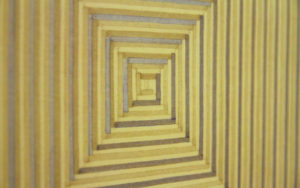
Paper has always been a staple throughout JoAnn Gonzalez Hickey’s life. She grew up receiving handwritten letters from her grandfather, and she sold stationary as a teenager. But it wasn’t until much later, after she spent years collecting drawings, that she grasped the connection between these early experiences and her current passion for art on paper.
The spirit of slowing down and asking questions — why is it that we like the art we like? — is the driving force behind Walk the Distance and Slow Down, showing at Boulder Museum of Contemporary Art (BMoCA) through Sept. 10. It’s composed of the works of 28 artists from the JoAnn Gonzalez Hickey collection, and it runs in conjunction with the Denver Art Museum’s Word Dance, based on the same collection.

Tasked with narrowing the 1,400 works down to 40 for the exhibition, BMoCA curator Mardee Goff selected a cross-section of art that captivated her, rather than adhering to any one theme or cherry-picking big names. She aims to inspire the same reaction in viewers.
“We want people to engage and really look,” she says. “There are lots of ways that people are going to get pulled in — each work has something that draws you.”
Hickey hopes that viewers will pay close attention not only to the art but to their personal reaction to the art.
“Both exhibitions are asking the viewers to slow down — to slow down and look and be with the work, to look close, to step in and step out of it. We’re so used to just flying by works because everything is so big and bold and easy to consume. Paper requires something very different, a different kind of engagement,” Hickey says. “If you’re aware and you’re paying attention, you will have feelings.”

What we feel when we interact with art comes as much from ourselves as it does from the outside, she continues. Rather than thinking about what we should like, we should pay attention to what we already do like. These preferences, Hickey suspects, come from our life experiences and unconscious memories.
She first noticed this several years ago while talking to the artist of a painting she’d bought. She told the artist that she had been drawn to the work because it conjured up music in her head. The artist, surprised, mentioned having worked in a pipe organ factory, a possible unconscious influence for the abstract drawing’s musicality.
“That just took my breath away because I spent all of my youth and years in college playing pipe organ,” Hickey says. “I was a pipe organ major.”
“At that moment I thought, ‘OK. From now on when I’m really looking at work [to buy], I’ve got to pay attention not only to the visual pleasure of the work to my eye, but I have to have a deep internal response,” she continues.
BMoCA plans to work with a CU Boulder neuroscientist to examine the art’s effect on the brain and explain how it may relate to our memories, as a kind of bonus feature midway through the exhibition’s run.

Walk the Distance and Slow Down also encourages questions about the medium itself, challenging notions about what drawing is. The varied works contain media that aren’t typically associated with drawing — paint, watercolor, tape, photos, maps, written words, books and the heavy manipulation of the paper itself.
“When you talk about drawings, people are going to think of a still life, or they’re going to think of a figurative drawing,” Hickey says. “People have no idea what drawings have become. That’s always the shock — it’s so much more than they ever imagined.”
Though most of us associate drawing with representation, nearly all of the works in the show are abstract. This invites another set of questions: What does it mean? Why was it made?
And not only are the media non-traditional — it’s often unclear how the drawings were made at all. Martí Cormand’s painstakingly photorealistic drawing of a work of art on crumpled paper leaves the viewer momentarily unsure what’s paper and what’s drawn. Simon Schubert’s “Treppenabgang + Spiegel + Tur” seems to depict an intricate architectural scene using only the shadows where the now flat paper was previously folded. Other works borrow elements of painting, sculpture and poetry, playing with the boundaries of the medium.
Despite their variety, the works are united by their common use of paper and prominent lines, and of course, their mystery.
The exhibition requires detailed exploration, and fortunately its presentation facilitates it. Magnifying glasses are available for inspecting the art. The card beside each work contains only basic information, but can be turned over to reveal more. And the exhibition sits in a circular hallway, meaning it has no beginning and no end. All of these things give the viewer a great deal of freedom in how to connect with each piece.

Ultimately, Hickey says that it’s these connections that make art worthwhile. If we don’t slow down and pay attention, how can we understand ourselves and relate to our world?
“I hope I’m playing a small role in helping people look,” Hickey says. “That’s again that human exchange. Isn’t that what art is about? Whether we go to the theater, or whether we read books, it’s that human exchange.”














